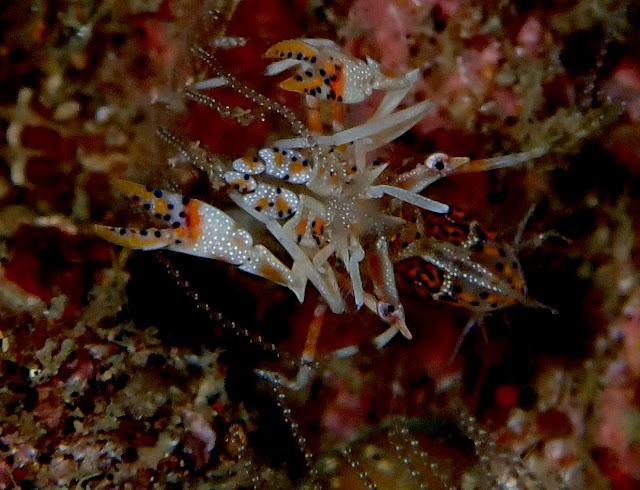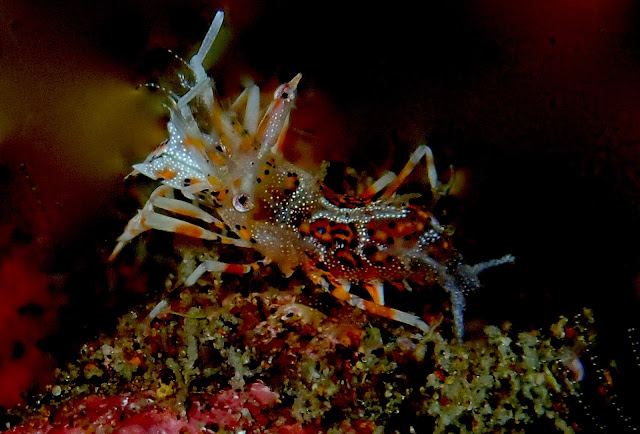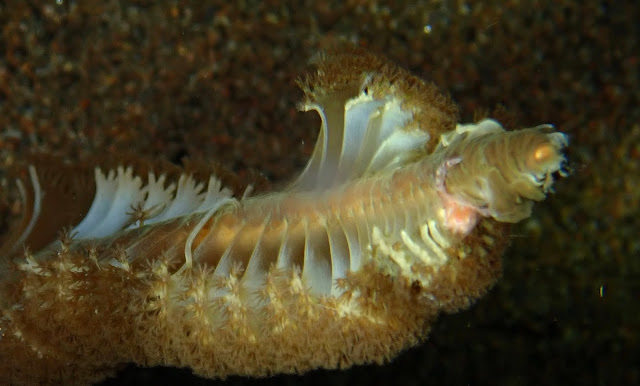Let's see what we can learn about next.
Shrimp and Crabs
I am not finding too much information on Shrimps. But from what i am reading, it seems common that Female Shrimps carry their eggs on their bodies. They make sure they get enough oxygen and remove any that die.
There are many different kinds of Shrimp. I'll start with a pretty common one.
Anemone Shrimp
They are either male or female and form monogamous relationships. They are almost always seen in pairs. Once they mate, the eggs develop on the female and when these hatch there are several larval stages that the larvae go through. The eggs are orange in color.
i've seen these Anemone Shrimp in other places. In Thailand they were called Peacock Anemone Shrimp and had a more colorful tail. The ones here have a blue tail; and are about 1" long, so i can see them, ..once i see them :) Since they are transparent, it is difficult to tell what is what. Their eyes are white dots at the opposite end of their blue tale.
since they are almost transparent, it's difficult to see them; except they are pretty wiggly, so they catch your attention. Here is a short video
This is a photo that i took of a pretty healthy green coral. It wasn't until i looked closely at the photo that i saw several Anemone Shrimps ... can you see them ?
Durban Dancing Shrimp
They obtain their name from the sideways movement that they perform usually at night. Although they are primarily nocturnal feeders they are seen out in the open in some areas during the day but this is rare. We saw quite a few of them during the day, but i guess at night there are swarms of them. These guys are larger ... about 2"
When i am snapping away, i don't always see what my camera does. When i saw this photo, i was wondering if i missed witnessing that White Eye Moral Eel eating the Dancing Shrimp. I just sent Gien a message and he said no, they are just typically in that same area. i guess they were just visiting :) But it makes a great photo... however deceptive
Banded Coral Cleaner Shrimp
This Shrimp is usually nocturnal as well. This photo was taken on a night dive. Shrimps eyes glow at night. Last year during a night snorkel the water was glittered with lights. i had to get down and see what it was ... they were all shrimp !
A 'cleaner' shrimp is usually approached by fish to have them clean/eat the parasites from their bodies. Other tiny fish do this as well, and it is not uncommon to see a big fish with it's mouth wide open and a tiny fish inside, cleaning it. That's what i call trust. The Banded Coral Shrimp uses its large chelipeds (that means claws, i had to look it up), and three sets of smaller claws called maxillipeds to scrape and pick off food and parasites from the fish host's body, mouth and gills or wherever needed. You can see those appendages in this photo, i guess with all that equipment you could do a pretty good job ! Taken during the day
Sexy Shrimp, aka Squat Shrimp
This Shrimp is a truly unique and fascinating shrimp to view and usually found among the tentacles of an Anemone Shrimp. It's eyes are the round white protrusions at the top. Hello Mr. Shrimp !
It exhibits an unusual trait of swaying its abdomen back and forth in the air, hence the name Sexy shrimp, or Squat Shrimp because their 'tail' is always in the air
Tiger Shrimp
The books list this species as
... 'Frequency of sightings: Rare'
... 'Really quick to hide, and very rarely seen but can be found at rubble or sponge'
... 3/4 inch long
Every day there were boats parked along our reef searching for it, because the word was out that it had been seen there. Maybe they didn't know that the best time to see it was at night ... and Gien knew where to look. Yes, we went on a Night Dive to find it. And find it he did. But DAMN, they are hard to see. The first one we saw was a juvenile, and more like 1/4 inch long. I stuck my camera down there, although i couldn't see it.
Gien found another one and wouldn't leave until i saw it. I finally saw 'something' and took several photos. They are beautiful ! This is a top-down view. Dots and sparkles and claws !
Although i think i would have called them a Leopard Shrimp ... at least this one
Exquisite !
i was sure i had nothing worth looking at so i was very proud of these photos when i saw them ;) Photographing at night is really much more difficult. The camera cannot focus unless there is light on the subject. That means in addition to keeping yourself steady, and not touching the sand, with camera in one hand, you have to hold a flashlight in the other hand ! Looking at the subject with the light, then trying to find the subject through the camera viewfinder, then your flashlight hand moves and you can't see, or the camera gets in the way of the light, and shadows the subject. It really takes a lot of coordination, experience .. and mostly luck ! It is amazing to me that the camera can pick out and focus on what you want it to. Like in this photo, there is a lot that the camera could have picked up, but somehow it focused on the shrimp.
Again, Gien was very helpful, especially on this one because he really wanted me to get a photo. He was also shining his light on the shrimp for me. That was a huge help ! I need a Camera Man ! ...or i need to buy a light for my camera like Phil has, so i don't have to hold a flashlight ! .....on my Christmas List !
Harlequin Shrimp
Now these guys are interesting. And very attractive and striking. They are also a 'prize' for diving photographers.
"They feed exclusively on sea stars, attacking and eventually subduing animals that may be 100 times their own weight and size. Even the huge, voracious Crown-of-Thorns, which have almost no natural enemies, are not safe around these guys. " Tail is on the right side ...
"If you’ve ever tried to lift a large sea star from a rocky substrate, you know about their strong grip"… (which of course you should not do) "It takes considerable effort even for a human. It’s hard to imagine how these little shrimp could prevail over such forces. Working as a team, one shrimp methodically snips suction-tube feet from each arm of its prey. Meanwhile, its partner grabs an arm-tip, and backs up like a tractor, gradually pulling the sea star over onto its back. Once that’s accomplished, the pair drag their hapless victim off to a preferred dining spot, typically under a rocky ledge or coral head. "
"Subduing such large prey must be a real challenge, but eating it all in one sitting would be a physical impossibility. However, nothing goes to waste, as the shrimp devour the sea star one arm at a time, keeping the increasingly disfigured animal as a live captive until every bit is eaten. Depending on the size of the sea star, this process may take up to two weeks… pretty horrific, huh? "
And they are only about 1 inch long ! I am borrowing the photo below from Phil. You can see both claws here, it's better
Mantis Shrimp
The last of our shrimps are the Mantis Shrimp. They are about 4inches long. We saw 2 different kinds.
Peacock Mantis Shrimp
Very colorful shrimp ! They are well known for their ability to 'punch', they 'smash' their prey
-- In the time it takes you to blink an eye, the mantis shrimp could theoretically punch 500 times.
-- Smashing mantis shrimps are found during the day scurrying around the reef hunting their prey, but disappearing into their holes when approached.
-- Smashers prefer to go for hardy prey like oysters, molluscs, crabs and snails because they prefer to smash their prey
There is a great video on YouTube that has 11 million views. It's worth watching, you will enjoy it, ...plus then i don't have to try to explain it: https://www.youtube.com/watch?v=F5FEj9U-CJM
Check out those 'boxing gloves'
The Eagle is famous for it's eye sight; but recently, (the article is from 2008), scientists have made a new discovery.
-- The Mantis Shrimp have the most complex eyes in the animal kingdom, and can see ultraviolet and polarized light.
-- They have 'trinocular' vision. Humans can see depth best with 2eyes, binocular vision, they can do this with either eye (had to look that up too, and the article went on and on, but lost me).
-- This gives them excellent eye sight with large eyes mounted on stalks that move independently at 360 degrees
-- Scientists are studying their eyes to try to build small cameras that can see cancer cells at very early stages
Check out these crazy eyes
Giant Mantis Shrimp
This other one is different in the following ways
-- It 'stabs' it's prey, rather than 'punching' it. It is armed with spiny appendages topped with barbed tips, used to stab and snag prey.
-- It has oblong shaped eyes, rather than round
-- As you can see, they also move independently
-- The Spearers go for softer prey like fish so that they can easily slice and snag them
-- Spearing mantis shrimps are usually found in their holes with just their heads showing, waiting for their prey. We saw this one at night, and he was mostly buried. One article said you 'never' see them out and about.
-- Some mantis shrimp species mate for life -- they meet the shrimp of their dreams and they share the same burrow, protect their eggs and help each other with hunting for their entire lives
-- They can live up to 20 years
In the case of the mantis shrimp, being called a shrimp isn't an insult -- they are swift, tough and effective death machines of the sea! ...but at least they kill swiftly, unlike those Harlequin Shrimps... cruel !
There doesn't seem to be too much to talk about with Crabs that i've seen ... or not seen. This is a photo of a Sea Pen that everyone was pointing at. i could see some tiny thread-like thing in the middle of the photo, so i tried to take a photo. And i did a pretty good job too. It wasn't until i saw the photo on my computer that i noticed at the very tip ..... was a pinkish crab ... that i was supposed to be seeing :(
Decorator Crabs
-- Are famous for their compulsion to attach debris collected from the ocean floor, plus tiny plants, sedentary animals, shells and gravel to themselves for camouflage.
Spider or Algae Crab
-- the body surface is generally covered with hairs, spines, and tubercles (knobby projections) that are frequently matted with algae, sponges, and other organisms.
-- It is fastened to themselves by means of a mucus like secretion from the mouth.
-- They rub pieces of algae against the backs of their shells until they stick, creating remarkable camouflage
-- They are also incredibly small
Orangutan Crab
This one is way cooler to look at ! It really does look like a miniature orangutan !
This is the first one i saw and i really didn't know what i was looking at ... i sound like a broken record, don't i ? The entire length of their body is less than 1/2 inch
-- They live on/in bubble coral
-- They are covered in reddish brown hair
-- It is also a Decorator Crab, but I don't think the Orangutan Crab needs any more decoration
-- Although sometimes it is laden with bits of “stuff” like shells or sand to increase its camouflaging capabilities
-- This is the same crab on a different day, notice that the green bubble coral is there, but he is on white. You can see his tiny red eyes
Phil thinks that someone poked and deflated the Bubble Coral in an effort to get a better photograph of the crab :( i don't know, but that's pretty rotten if they did.
-- They usually sit and wait for plankton to stick in its luscious locks, which it then picks off as snack food for the day. It uses its claws to “groom” out the tiny food stuffs and then plops the plankton into its mouth.
-- So, again, we see a resemblance to the ape orangutan in that picking off parasites
-- I was the last one to take a turn at photos, and wouldn't you know it ... he posed for me, stretching his arms out like an ape !
Crinoid Crab aka Squat Lobster
-- Not a Decorator Crab, and it is not a Lobster, despite it's other name
-- It lives within the 'arms' of the Crinoid
-- This is a Crinoid, also called Sea Feather
-- Working as a miniature house cleaner, these crustaceans quite often take on the colors of their host in order to camouflage themselves further from predators ... and i'd say he did a fine job !
-- I couldn't see it then; and honestly, i have a hard time deciphering the 'body parts' now
-- Taken on a night dive
-- I think those are the 'claws' at about 10:00 and 11:00
Stay tuned ... up next are Fish, including the FrogFish and Mandarin Fish !



























No comments:
Post a Comment